Стюартия, ложная камелия
Stewartia псевдокамелия принадлежит к семейству Theaceae, как и камелия. Более известный как стевартия, он является частью одноименного рода, который включает около 80 видов деревьев и кустарников, произрастающих в Азии или Соединенных Штатах. Наше небольшое деревце в данном случае является частью азиатской стюартии. Хотя в исходной местности он легко превышает 15 метров в высоту, в нашем климате он не дотянется до более 5 метров..
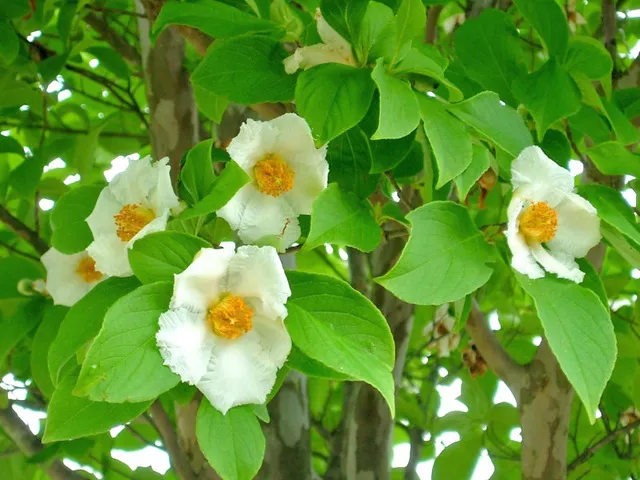
Стюартия в первые годы своего существования имеет коническую форму, даже столбчатую, с довольно низко разветвляющимся стволом. При созревании крона становится округлой. Спустя 10 лет его гладкая кора отслаивается, образуя красивые пятна от розового до красновато-коричневого цвета, очень эстетично зимой. Овальные и зеленые листья приобретают очень красивые осенние краски, переходя от желтого к оранжевому, затем к красному, прежде чем упасть. В белые цветы с множеством тычинок желтые цветы распускаются одна за другой в течение двух летних месяцев.
Несмотря на все свои сильные стороны, стюартия остается редкостью в садах; Надо сказать, что его трансплантация — деликатная операция. Однако, если вам посчастливилось приветствовать его в своем доме, выберите вождение, которое уважает его естественную гавань, то есть в cépée : это помогает подчеркнуть привлекательную кору. Вождение штанги возможно, но требует времени из-за медленный рост.
FAQ — 💬
What is a Stewartia tree?
stewartia, any member of a genus ( Stewartia) of at least nine species of shrubs and small trees, in the tea family (Theaceae), native to East Asia and eastern North America. They are planted as ornamentals in warm areas for their showy camellia-like flowers and their strikingly coloured, peeling bark.
What is Stewartia pseudocamellia?
Stewartia pseudocamellia, commonly called Japanese stewartia, is a small, slow-growing, pyramidal, deciduous tree native to the mountains of Japan and the Korean peninsula. Specimens in the wild can reach 50-60′ tall, but in cultivation typically mature over time to 20-40′ tall with a slightly narrower canopy width.
What is Japanese stewartia?
Japanese stewartia is a multiseason-interest plant that makes an excellent specimen tree for a front yard or a focal point near a patio or outdoor room.
Is Stewartia a synonym of Dombeya?
Stewartia as described by Philibert Commerçon is a synonym of Dombeya. Stewartia (sometimes spelled Stuartia ) is a genus of 8-20 species of flowering plants in the family Theaceae, related to Camellia.
Stewartia Tree Growing Conditions
These trees like acidic soil; they like things moist and do not do well in chalk, calcium-rich soil, or a dry sandy environment. They want rain and do not tolerate drought.
These trees grow slowly until they are established, reaching 20 to 25 feet tall and having a multi-trunked form with somewhat horizontal branches.
When planting, it is advisable to position your tree in full sun or partial shade; they do not like direct, strong afternoon sunlight.
This genus does better in moderately cooler climates.
Stewartia trees can grow at a rate of 24 inches per year.
Water
Water regularly to maintain wet or evenly moist soil weekly or more.
There is mixed information about drought intolerance, so keep an eye out for signs of heat damage.
Most local growers suggest keeping them moist but not soggy.
Growing Difficulty
The Stewartia tree does not always do well with other trees and shrubs.
News on the street is that they are somewhat challenging to establish; however, once they get established, they are relatively easy as long as they get enough water and are in well-drained soil.
You may want to start with well-grown nursery stock, put it in a spot that does not have too much sun in the afternoon, and water carefully the first few years.
Advantages of Stewartia Trees
Landscapers like this ornamental tree because, unlike most flowering trees, it blooms in mid to late summer until the first nippy days of Fall.
They have large white blooms anywhere from three to 11 cm in diameter with five petals.
Occasionally they may present with six to eight petals.
Their bark is unique in that it has a smooth orange to yellow color that peels in fine flakes.
The leaves turn a beautiful orange during the fall.
The Japanese Stewartia especially is a noninvasive species and does not drop leaves and fruit.
The seed pod forms a cylindrical cone with a woody oval-shaped capsule.
The shape is unique and decorative in dry floral arrangements.
Stewartia Facts
- Most notably, the Stewartia serves as the collective common name for a genus of beautiful flowering plants. in point of fact, the various members of the group bear a close relationship to the equally lovely camellia. For the moment, scientists place approximately 20 recognized species within this marvelous grouping of flowering plants.
- In addition, the great beauty of the various plants placed in the scientific group has led to an extreme popularity with the public. As a result, several members of this genus have also become quite popular as ornamental plants. This popularity occurs because of the fact that the varieties in question actually possess orange bark, and bloom when most trees lie dormant.
- Sometimes referred to by the alternate spelling of Stuartia, the amazing plants also remain the source of some debate. That’s because many botanists dispute the placement of different species within the genus. By whatever name one calls it, all forms of the Stewartia remain stunning plants. Quite unfortunately, several members of this group now qualify as Endangered.
Pruning and Propagation
Stewartias are naturally neat and tidy in shape and do not need much pruning.
They are amiable to pruning and shaping if the gardener or landscaper so desires.
Smaller varieties can be sheared into a formal hedge if trees are planted closer together.
Top Tip: It is advisable to cut crossing or misdirected branches in the early years of growth and remove lower limbs as the tree gains height.
Stewartia henryae is an open-pollinated cross hybrid between Stewartia pseudocamellia and Stewartia monadelpha.
This plant offers a unique blend between the two parent species.
Most display white flowers like the S. monadelpha and bark like the S. pseudocamellia.
Stewartia Physical Description
First of all, all known forms of the fascinating Stewartia understandably have many physical characteristics in common with each other. This mainly holds true due to the fact that every plant within the genus appears as either a tree or a shrub. Furthermore, the majority of these develop as deciduous. Nevertheless, a few of the different species developed as evergreen in nature.
Quite interestingly, those plants evolving in different parts of the world develop different characteristics. The species endemic to one region include both evergreen and deciduous varieties. Depending on the exact species, these attain heights ranging from 9.8-65.5 ft (3-20 m). But, those endemic to another region all develop as the large shrub variety. These attain a range of heights from 9.8-16.4 ft (3-5 m).
In addition, the bark of all varieties of Stewartia presents its own distinctive qualities. That’s because this has a highly distinctive appearance. In color, it typically presents as a yellow-brown to orange in color. Further, the flowers of most plants in this genus grow large and extremely conspicuous. These blooms may be as large as 4 in (10 cm) in diameter. Finally, in color these typically show white.
- Kingdom: Plantae
- Phylum: Tracheophytes
- Class: Angiosperm
- Order: Ericales
- Family: Theaceae
- Genus: Stewartia
 Source: https://bit.ly/2Jeoe9gPhotographer: UleliCC License: https://bit.ly/3aHHg1j
Source: https://bit.ly/2Jeoe9gPhotographer: UleliCC License: https://bit.ly/3aHHg1j
Первые шаги после покупки
Стюартию можно приобрести в виде небольшого молодого деревца или кустарника. В торговом центре рекомендуется тщательно осмотреть понравившийся экземпляр на отсутствие вредителей и распространенных болезней. Стебли и листья не должны иметь каких-либо следов повреждений. Если на вид кустарник выглядит привлекательно, не наблюдается желтизны листьев и молодых побегов, его можно смело покупать.
После транспортировки растение помещают в слегка притененное место восточной или западной экспозиции помещения. Обязательно следует умеренно полить почву теплой, отфильтрованной водой, а также опрыскать декоративную листву.
Stewartia Tree Appearance and Characteristics
This is a beautiful tree with big 2-2 ½ inch white flowers with orange centers. The flower generally has five petals but sometimes can have up to six to eight.
They are shaped like a Camellia.
Each flower is short-lived, but many are produced that open over many weeks.
Stewartia bloom in July to mid to late summer.
It has green leaves and unique peeling bark.
The bark is smooth textured and exfoliates as the plant ages.
It has a molted, camouflaged appearance from yellow to an orange and mixed grey pattern.
The seed pods are cylindrical with an oval woody shape.
Each cylinder has five chambers, and each chamber consists of five seeds.
Gardeners can collect the seeds from the dry seed capsule before they burst in the fall.
When the leaves change color from deep green to yellow and red in the fall, it provides a beautiful display of color.
Выращивание Стюартии
Сажайте стеварцию из контейнеров осенью или ранней весной, смешивая с посадочным местом обильное количество компоста. При необходимости добавьте в почву торф или серу, чтобы сделать ее кислой.
Уход
Поливайте еженедельно в течение первых нескольких лет, чтобы растения прижились. После укоренения достаточно глубокого полива каждые несколько недель. Поддерживайте глубокий слой мульчи над корневой системой, чтобы сохранять прохладу, сохранять влагу и ограничивать рост сорняков.
Стюартии обычно приобретают привлекательную форму без обрезки, но при желании они легко поддаются обрезке и формированию. Удаление нижних конечностей по мере их роста обнажает их привлекательные стволы и кору. Более мелкие сорта можно даже состричь в формальную живую изгородь.
Стюартии обычно не подвержены вредителям и болезням.
Выращивание
Для успешного выращивания Стюартии особое внимание уделяют субстрату, в котором произрастает растение. Почва должна быть обязательно высокой кислотности, питательной и воздухопроницаемой
Пересаживают растение каждые два-три года по мере роста корневой системы. При этом не забывают подрезать корни. На дно горшка насыпают дренажный слой.
Для выращивания Стюартии в открытом грунте в саду также подойдет плодородная, кислая почва. Причем для посадки деревца выбирают хорошо увлажненное место, поскольку растение не переносит засухи.
Комплексные минеральные удобрения для бонсай вносят в период активного роста дерева раз на десять дней. Ближе к осени частоту подкормок уменьшают и совсем прекращают зимой, создавая растению условия для перехода в состояние покоя.
Стюартия хорошо переносит обрезку, поэтому с целью придать кроне красивый, ухоженный вид, сильнорастущие побеги укорачивают. Сухие ветки и многочисленную поросль удаляют. Крону формируют в обязательном порядке перед началом вегетации, то есть ранней весной.
Деревце на зиму сбрасывает листву, но декоративная крона бонсай даже без листьев в холодный период смотрится эффектно.
Посадка и выращивание стевартии
Экспозиция
Оттенок детали это экспонат, который больше всего нравится стюартии. Ему достаточно нескольких часов полного солнца, и он боится густой тени. Расположение на краю подходит для этого, даже если лучшее место для знакомства с его достопримечательностями остается изолированным объектом.
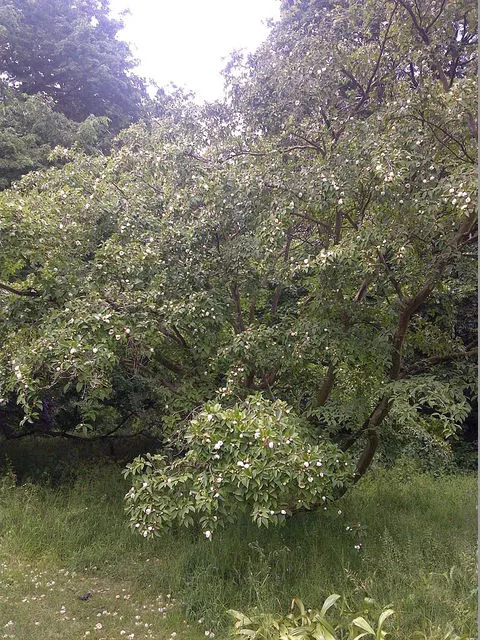
Земля
Гумус и легкий, от кислого до нейтрального, от холодного до влажного. В то время как Stewartia принимает случайную переувлажненную почву, это не относится к почвам, которые пересыхают.
Посадка
Stewartia нужно сажать молодыми, потому что он не поддерживает пересадку. В посадка производится комьями, весной или даже осенью. Установите его в защищенном от ветра месте, где у него будет место для естественного распространения (посчитайте примерно 2–3 метра размаха крыльев).
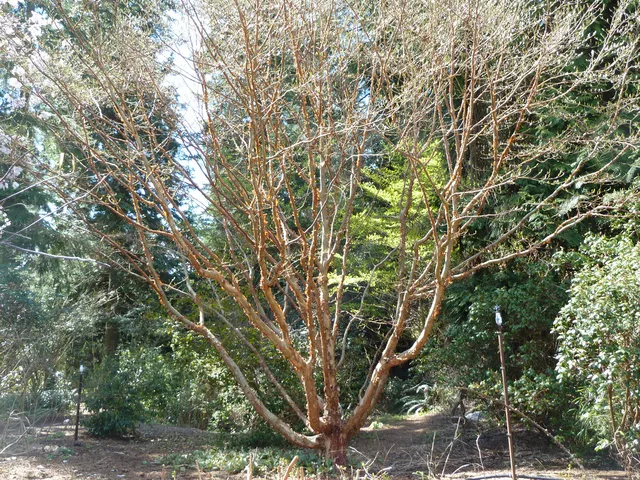
Обслуживание
После посадки саженца следует позаботиться о том, чтобы почва оставалась прохладной, особенно летом, в первые годы.
В размер не нужен. Однако, чтобы выделить его ветви зимой, вы можете проредить его, удалив менее удачно расположенные ветви.
Создание органическая мульча способствует поддержанию перегноя, свежести и кислотности почвы при использовании хвои.
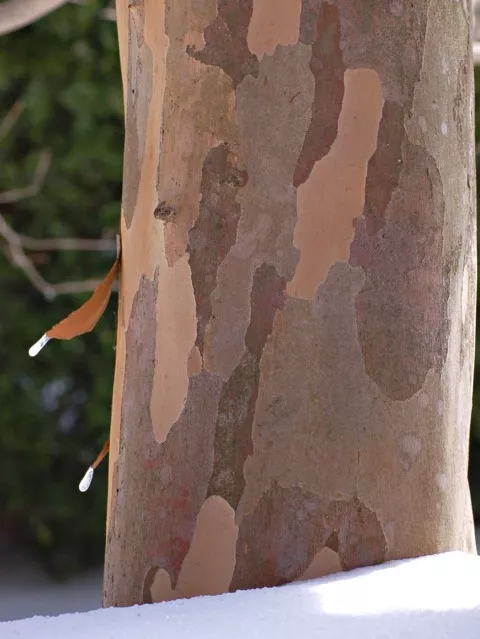
Description
Stewartia rostrata is a deciduous shrub or small tree known for its beautiful flowers, attractive bark, and brilliant fall foliage, making it a plant of significant ornamental value. It is not known to have significant commercial value, nor is it considered invasive or problematic.
Leaves
The leaves of Stewartia rostrata are elliptic to ovate, with finely serrated margins, and they turn a range of colors from yellow to red in the fall.
Flower
The flowers are one of the plant’s most striking features. They are white with a cluster of yellow stamens in the center and bloom in the summer. The flowers are camellia-like in appearance, which is not surprising given that both genera belong to the family Theaceae.
Fruit
The fruit of Stewartia rostrata is a capsule with a distinctive beak-like projection, which is the origin of the common name “beaked stewartia.”
Stem
The bark of Stewartia rostrata is smooth and exfoliates in patches, revealing a mottled pattern of colors beneath, including shades of gray, brown, and orange.
Caresheet Data
Plant Name:
stewartia rostrata
Etymology:
Genus: Stewartia – Named after John Stuart, 3rd Earl of Bute, an 18th-century Scottish nobleman and botanist. Species: rostrata – Derived from Latin “rostratus,” meaning “beaked,” referring to a characteristic of the plant’s capsules or other parts.
Common Name:
Beaked Stewartia
Genus:
Stewartia
Species:
rostrata
Family:
Theaceae
Height:
60-80 in / 5-6.7 ft / 152-203 cm / 1.5-2 m
Width and Spread:
2-3 m / 6-10 ft / 200-300 cm / 2-3 m
Plant Type:
Stewartia rostrata is a type of flowering plant in the family Theaceae.
Habit/Form:
Shrub or small tree
Leaf Type:
Deciduous, simple, alternate, elliptic to oblong with serrated margins
Leaf Arrangement:
Alternate
Leaf Shape:
Obovate to elliptic
Leaf Margin:
Serrulate (finely serrated)
Leaf Color:
Green
Fragrance:
Stewartia rostrata has a mild fragrance, not strongly characterized.
Stem Description:
Slender, zigzag, glabrous
Stem Is Aromatic:
No
Texture:
Smooth with peeling flakes
Leaf Feel:
Smooth and leathery
Leaf Length:
5-12 cm
Leaf Description:
Alternate, simple, elliptic to oblong, finely serrated margins, 5-12 cm long, glabrous above, glaucous beneath.
Hairs Present:
No
Light Requirements:
Partial shade to full sun
Soil Preference:
Acidic, well-drained soil
Water Requirements:
Medium moisture, well-drained soil
Fertilizer Requirements:
Balanced, slow-release fertilizer applied in spring.
Pruning Requirements:
Prune to shape and remove dead or broken branches; minimal pruning required.
Seed Germination Time:
7-42 days
Display/Harvest Time:
Not applicable (Stewartia rostrata is not cultivated for harvest)
Fruit/Seed Production:
Capsules
Growth Rate:
Slow to moderate
Growth Habit:
Shrub or small tree
Root System Type:
Fibrous root system
Fruit Type:
Capsule
Fruit Description:
Capsule, woody, five-valved, ovoid to globose, 1-1.5 cm long, brown when mature.
Flower Color:
White
Flower Shape:
Campanulate (bell-shaped)
Flower Inflorescence:
Axillary, solitary, camellia-like flowers
Flowering Season:
Late spring to early summer
Bloom Duration:
4-6 weeks
Drought Tolerance:
Moderate
Frost Tolerance:
-20°C (-4°F)
Heat Tolerance:
Not well-documented; prefers cooler, temperate climates
Wind Tolerance:
Not well-documented
Shade Tolerance:
Intermediate
Salt Tolerance:
Low salt tolerance
Soil Compaction Tolerance:
Low
USDA Plant Hardiness Zones:
6-8
Photoperiod Sensitivity:
Not documented
Pollinator Attraction:
Yes; bees, butterflies.
Wildlife Value:
Attracts pollinators; provides nectar and pollen.
Problematic Insects:
Japanese beetles, spider mites, scale insects
Allelopathic Properties:
No
Habitat Enhancement:
Stewartia rostrata provides habitat and food for wildlife, stabilizes soil, and adds aesthetic value with its flowers.
Erosion Control Potential:
Unknown
Landscape Location:
Woodland gardens, shaded borders
Landscape Theme:
Woodland Garden; Asian/Zen Garden; Specimen Planting
Design Feature:
Yes, Stewartia rostrata is used as a design feature in landscaping for its ornamental value, including its camellia-like flowers, attractive bark, and fall color.
Ethnobotanical Significance:
Stewartia rostrata has no significant ethnobotanical uses documented.
Naturalization Ability:
Unknown/not well-documented
Companion Planting Suitability:
No specific companion planting data available
Edibility:
No.
Edible Parts:
No parts of Stewartia rostrata are known to be edible.
Toxicity:
No
Poison Parts of Plant:
No parts poisonous
Toxic to Humans:
No known toxicity to humans.
Toxic to Cats:
No known toxicity to cats.
Toxic to Dogs:
No known toxicity to dogs
Causes Contact Dermatitis:
No known evidence.
Air Purification Qualities:
No specific air purification qualities reported
Medicinal Properties:
No well-documented medicinal properties.
Thorniness or Spikiness:
No
Cultivation and Care
Planting
When planting Stewartia rostrata, it is best to do so in the spring or fall. The plant should be situated in a hole that is twice as wide as the root ball and of the same depth.
Watering
Stewartia rostrata requires regular watering, especially during dry spells, but it does not tolerate waterlogged conditions.
Pruning
Pruning is generally not necessary for Stewartia rostrata, but if shaping or size reduction is required, it should be done after flowering. Use clean, sharp pruning shears or loppers to remove any dead, damaged, or diseased branches. Cut just above a leaf node or bud that is facing the direction you want new growth to go.
Propagation
Propagation is typically done by seed or cuttings. However, seeds can be difficult to germinate and may require stratification, while cuttings should be taken in the summer and rooted under mist.
Stewartia Distribution, Habitat, and Ecology
Perhaps most worth noting, the great majority of the breathtaking Stewartia varieties developed within the area now known as eastern Asia. More specifically, this area includes Japan, China, Korea, and Thailand, just to name a few of the countries in which it appears in this vast area of the world.
However, two of the species placed within the scientific grouping appear to be native to specific regions within North America. These species, themselves impressive, occur naturally in a wide range. That’s a zone extending from the states of Virginia and Kentucky to Florida and Louisiana, in the United States.
This impressive genus also has highly specific, and somewhat unusual, habitat requirements. That’s because it generally appears in regions composed of soil with a high acidity level. Furthermore, the plants also require prolific quantities of rainfall and does not tolerate drought conditions.
Stewartia Tree Growing Guide
If you are starting from seeds, many people stratify them first.
Stratification is a horticulture process that stimulates the natural conditions the seeds must go through before germination can occur.
It is an embryonic dormancy period, and most seeds will not sprout until that dormancy phase is broken.
Stewartia seeds need a stratification process.
The seeds need to be kept at warm temperatures of 15-20 degrees C (59-68 degrees F) for 120 days and then in cold stratification for 90 days.
Most people refrigerate their seeds for 90 days.
Some gardeners choose to stratify warm followed by cold stratification periods by planting the seeds in the summer in a mulched bed for expected germination the following spring.
This really depends on how cold the winters are in your areas.
Stratification: Warm stratify for 120 days.
Cold satisfy for 90 days.
After stratification, a process known as scarification takes place by soaking your seeds in water at room temperature for 24 hours before planting.
To germinate, sow the seeds ⅛” deep, press down the soil, level it, and add mulch to keep the seedbed moist.
You May Also Like: The Complete Bayberry Bush Growing Guide
Potting and Repotting
You can transplant a small tree from a nursery in early spring or from a container to a bigger container as needed; however, they do not like transplanting.
The tree grows best in evenly moist, moderately acidic soil with good drainage when planted in the ground.
It does not do well in heavy clay, dry or rocky soils, or soils that do not drain well.
Note: It will have difficulty taking in necessary nutrients in neutral or alkaline soil.
It does not readily establish itself with other common garden trees and shrubs.
Companion Plants for Stewartia Trees
Suggested companion plants for Stewartia include Hakonechloa macra, commonly known as Japanese forest grass, a golden shade-loving perennial, Sunburst Hypericum, and Japanese Spurge.
You can also pair them with low-maintenance shrubs like shrub roses, spirea, and ninebark.
Stewartia Trees Diseases and Pest Problems
Like most trees, damage or injury to the bark of the tree can lead to problems.
This tree is relatively hardy without known pests or disease; however, every tree is susceptible to disease.
It pays to take some precautions to keep the tree healthy.
Plant the tree in the spring rather than the fall to avoid it toppling over in winter storms.
Young trees can benefit from some support in their growing years to stabilize them until their root system propagates and their trunk becomes sturdy to withstand the climate and wind.
If the leaves are exposed to too much afternoon sun, they can get sunburned, known as “leaf burn”.
Heat stress can weaken the tree.
It will then become more susceptible to pests or disease.
Avoid this by placing your tree in a partially shaded area or in an area that does not get direct sunlight for hours on end during the day.
When the bark gets damaged, it is like our skin getting cut.
This leads to open exposure to invite germs or pests.
Stewartia has a fragile bark that can easily be damaged.
It is important to be careful not to cut the tree bark when pruning or mowing around it.
Once the trunk is established, you might think of placing decorative rocks or gravel around it, or possibly a low fence around the trunk so that it won’t be harmed when mowing or weed whacking too close to the tree’s trunk.
If leaves become brown, it may mean that you are overwatering your tree.
The Stewartia tree needs moisture but does not overwater the tree as it can develop root rot.
Stewartia Tree Seeds
You can order Stewartia pseudocamellia (Japanese Stweartia) 3-year-old trees from Japanese Maples and Evergreens on Amazon.com if you live in the US.
Stewartia Pseudocamellia Unique Tree jocad (5 seeds)
Сверхмодные «почти экзоты»
Есть и растения, у которых сегодня статус экзота можно считать спорным. Все дело в том, что эти культуры в результате резкого скачка популярности и установления садовой моды на посадку в декоративных композициях в последнее время встречаются в садовых центрах практически на каждом углу. И уже не могут считаться столь необычными, как экзоты с гораздо меньшей популярностью. По происхождению и броскости они и правда экзоты, но мода постепенно меняет их статус.
К числу таких растений безусловно принадлежит любительница кислых почв ложная камелия Стюартия псевдокамеллия (Stewartia pseudocamellia). Чуть более десятка лет назад о ней практически никто не слышал, но сегодня она неизменно встречаются в ассортименте красивоцветущих европейских кустарников. Белые чашевидные цветки и очень яркий осенний окрас кроны да хорошая зимостойкость в условиях, аналогичных Западной Европе, сделали стюартию практически столь же популярной на Западе, как и рододендроны. Да и кора у нее очень оригинальна, неравномерно цветная и отслаивающаяся. И является ли она до сих пор экзотом, среди дизайнеров ведутся активные споры. По зимостойкости схожа с тюльпанным деревом, а с возрастом все более вынослива.
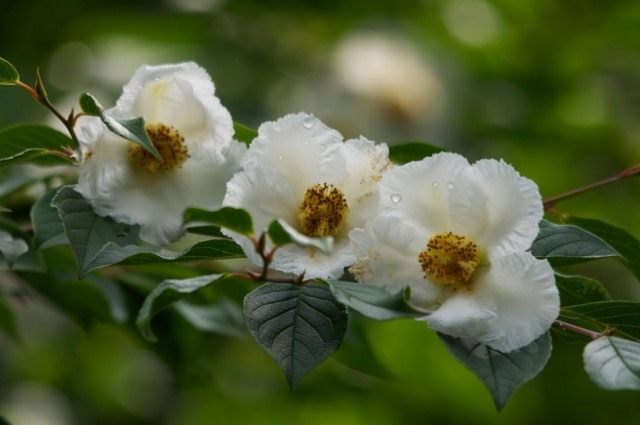
Практически тот же самый взлет популярности в последнее время характерен и для других кустарников и древесных. К экзотам, становящимся все более привычными, принадлежат:
- Желтоцветковая Вейгела Миддендорфа (Weigela middendorffiana). Она настолько внешне отличается от обычных вейгел с белыми и розовыми цветками, что кажется совершенно другим кустарником. Вырастает до 1,5 м и зацветает в мае-июне, способна к повторному позднелетнему цветению желтая вейгела незначительно обмерзает, при своевременной формирующей обрезке после цветения пышно цветет даже в средней полосе.
- Ель восточная (Picea orientalis) золотистой формы «Aureospica» с укороченной хвоей и филигранным строением ветвей, под
Экзоты под боком: советы по поиску и выбору
Любой ландшафтный дизайнер, да и опытный садовод подтвердит, что способов придать своему саду индивидуальный облик есть два:
- Работа со всем ландшафтом, создание уникальных композиций, внимательное продумывание каждой детали от структуры до линий, подбора красок и аксессуаров.
- Введение всего 1-2-х растений, но принадлежащих к числу необычных, эксклюзивных деревьев и кустарников. Они могут заменить тщательно продуманный дизайн и восполнить недостаточную оригинальность любого проекта. Правда, в поиске таких особенных растений лучше быть осторожным и придерживаться некоторых правил.
Любуясь экзотическими растениями, поддаваясь очарованию тропических садов и с любовью осматривая пейзажи дальних стран во время отдыха, садоводы всего мира вдохновляются, а затем часто стараются привнести и в свой сад несколько необычных и понравившихся штрихов. Но в поисках экзотики для своего сада – растений необычных, встречающихся крайне редко – нужно быть осторожным и внимательным. Просто купить саженец в зарубежных магазинах для того, чтобы ваш участок украсило экзотическое дерево или кустарник, будет мало.
Скорее всего такое растение не приживется
Особую осторожность следует проявлять по отношению к тем растениям, которые очень популярны в европейском садоводстве. Их зимостойкость для Западной Европы вовсе не означает, что в средней полосе растения выживут
Поэтому из европейских каталогов выписываете культуры только после консультации с опытными садоводами или после проверки степени их зимостойкости. Иначе долгожданные новинки скорее всего погибнут в течение первой же зимы.
В поиске самых необычных крупных растений для своего участка стоит придерживаться тех же правил, по которым вы подбираете более привычные культуры. В первую очередь, ориентируйтесь на местные сорта и ассортимент местных питомников и садовых центров, каталоги ландшафтных фирм в вашей стране. Лучшие садоводы вашего региона уже наверняка испытали десятки различных видов растений и методом проб и ошибок обнаружили те культуры, которые способны адаптироваться к конкретному климату. Наряду с привычными нам растениями все без исключения питомники продают и экзотические новинки. И порой это те же самые виды и сорта растений, которые мы так стремимся купить на зарубежных сайтах. Но благодаря многолетнему выращиванию в идентичных вашему саду или близких к нему климатических условиях такие растения гораздо более стойки и выносливы. И риск потерять их намного меньше. Так что, если вы хотите украсить свой сад экзотической новинкой и выделиться на фоне соседей, то в первую очередь внимательней нужно присмотреться к ассортименту деревьев и кустарников в местных садоводческих хозяйствах. В их каталогах вы точно встретите необычные, но хорошо подходящие для вашего сада культуры. И количество таких растений будет точно больше одного десятка. Так что свой идеальный экзотический акцент наверняка ближе, чем кажется.
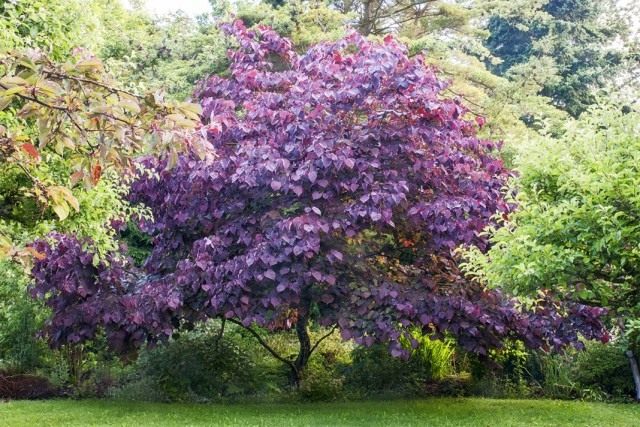
Еще один прекрасный вариант поиска экзотических кустарников и древесных растений – посещение выставок и ярмарок. Ведь в них участвуют не только крупные садовые центры, но и частные садовые хозяйства и даже отдельные садоводы, успехи которых могут пригодиться и вам. В крайнем случае, вы всегда сможете спросить совета и наставлений в поиске способных хорошо адаптироваться к вашему климату экзотических культур.
Надежным источником информации о зимостойкости и испытаниях в культуре разнообразных экзотических растений всегда служили и служат сегодня ботанические сады. Они также предлагают экзотические растения на продажу, а в их ассортименте встречаются те растения, которые невозможно отыскать в питомниках и садовых центрах.
Решаясь на поиск экзотического растения для своего сада, необходимо запастись не только настойчивостью и терпением, приготовиться к длительному и требующему взвешенных решений поиску, но и тщательно рассчитать свой бюджет. Дело в том, что такие растения из-за своей редкости, сложности селекции и размножения, скорее всего, будут стоить немало. Наряду с хвойными деревьями именно экзоты считаются наиболее дорогостоящим видом из саженцев.
Секреты успеха
Стюартия считается универсальным растением, которое может расти как в домашних условиях, так и в открытом грунте. Интересная особенность произрастания дерева — его широкий температурный диапазон, в условиях которого Стюартия прекрасно себя чувствует. Она выдерживает и высокую плюсовую температуру, и понижение столбика термометра до -20°С.
Растение предпочитает освещенное место, но может выдерживать и полутень. Поэтому для успешного выращивания наиболее подойдет восточная или западная сторона помещения. В южной экспозиции кустарник следует притенять, чтобы избежать ожогов нежных листьев.
В период активного роста Стюартию поливают два раза в неделю, особенно в жаркие летние дни, по мере высыхания верхнего слоя почвы. Молодые растения особенно нуждаются в частом поливе. В осенне-зимнее время увлажнение грунта постепенно сокращают к минимуму, переводя деревце в период вынужденного покоя.
Опрыскивают Стюартию по мере надобности — в летний период.














